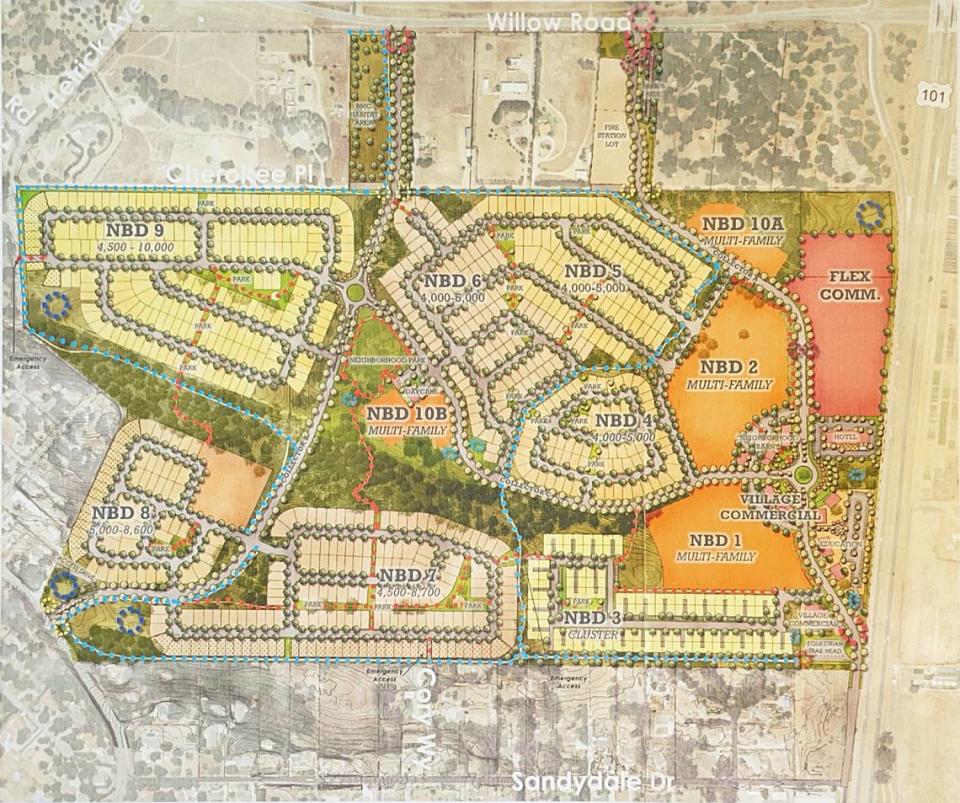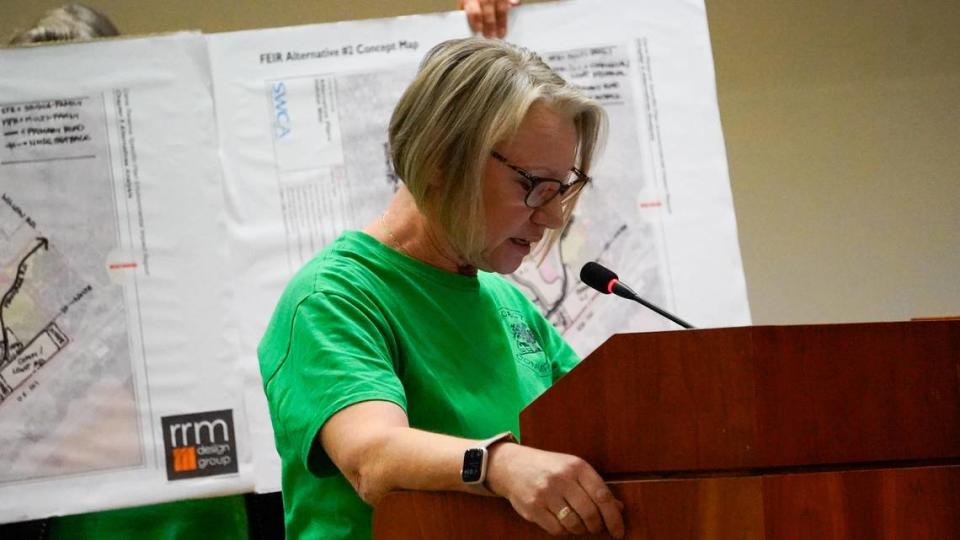Dana Reserve housing development clears SLO County Planning Commission — but with key changes
A major housing development that would bring more than 1,400 homes to Nipomo is one step closer to becoming a reality after the San Luis Obispo County Planning Commission approved the project on Tuesday.
After two days of hearings, the Planning Commission voted 4-1 to recommend the Dana Reserve project to the San Luis Obispo County Board of Supervisors for final approval.
During the hearings, commissioners heard from project developer Nick Tompkins, as well as a range of stakeholders and members of the public.
Ultimately, the Planning Commission recommended several changes to the project to add more affordable housing and lower impacts on nearby schools, which Tompkins said will be taken under advisement going into the project’s final approval at the Board of Supervisors.
“I feel good but still have a ways to go and actually lots more to do,” Tompkins told The Tribune after the vote. “I appreciated the commission’s thoughts and recognition of the need for housing, and hopefully we can play a significant part of that.”
What is that in SLO County?
Ever wonder what that construction is in your town? Or what happened to that cool project that was proposed? We’re finding out the answers as part of a new series. Send us your questions and tips by emailing reporter Kaytlyn Leslie at kleslie@thetribunenews.com.
• • •
Related Stories
• SLO County project to feature 59 condos. Get a look at the plans
• 'Shopping center of the future' finally taking shape in Atascadero
Planning Commission recommends changes to increase affordable housing
At the hearing, the commissioners recommended Tompkins’ development company, NKT Commercial, make several changes to the project.
One of the recommendations was to increase the amount of affordable housing by adding more People’s Self-Help Housing units and accessory dwelling units.
Previously, the project consisted of 1,318 homes across 10 neighborhoods, the majority of which were intended to be affordable to the county’s workforce, with People’s Self-Help Housing receiving a donation of land to build 104 affordable homes.
With the Planning Commission’s recommendation, People’s Self-Help Housing will now have the space to build 156 affordable homes. Commissioners also recommended adding 100 junior accessory dwelling units, which are under 400 square feet and attached to the main dwelling, to some of the parcels.

In total, the final version of the Dana Reserve Specific Plan now includes 1,470 units after adding the additional People’s Self-Help Housing homes and ADUs, Tompkins said.
During discussion, Commissioner Anne Wyatt — the sole “no” vote against the project — said NKT Commercial could have promised to build the affordable units itself instead of donating the land to People’s Self-Help Housing, which will need to request tax credits from the county to make the homes feasible.
She also criticized the amount of habitat the project will destroy in the development process.
“The Dana Reserve promises multiple benefits to county residents, including donation of land to People’s Self-Help Housing,” Wyatt said in an email to The Tribune. “It’s disappointing we missed opportunities including any requirement that the developer actually construct affordable housing so desperately needed and called for by the community, and we failed to minimize the substantial project impacts, particularly losses of oak forest and woodlands, biodiverse habitat, (which is) not replaceable.”
The commissioners also recommended NKT Commercial drop the age restriction requirement for three of its neighborhoods, which initially were planned to limit to buyers over the age of 55.
The Planning Commission recommended some development fees collected from the project be allocated to the Nipomo Community Center, and recommended adding a local hire requirement for the project’s construction.
It also recommended the project increase bicycle and pedestrian connections between the development and the adjacent Dana and Nipomo elementary schools, in response to concerns that nearby Dorothea Lange Elementary School cannot accommodate the projected influx of students.
Finally, the commissioners recommended NKT Commercial and county planning staff meet with the Nipomo Action Committee, South County Advisory Council and Nipomo Botanical Garden to develop a community-supported alternative, which the Board of Supervisors could choose as an alternative to the final specific plan.
“Sometimes, I sit back and think that the reason there are so many bills coming down on housing from the state is because it takes so long for anything to get done locally,” Commissioner Kristina Simpson-Spearman said during the meeting. “We’ve had people talk about all different aspects of this project, but we’ve also had many people talk about their desire to have a home.”

Oak trees remain central issue for Nipomo development
Going into the Planning Commission hearing, NKT Commercial made a handful of additional tweaks to the specific plan, mainly centered around keeping more of the property’s existing oak trees — something that the project’s detractors have previously rallied behind.
With the changes, Collector A — one of the two roads that will branch south from Willow Road through the development — was rerouted to the west to avoid around 200 oak trees, while neighborhood 10 was split into two locations to avoid 186 oak trees and Neighborhood 9 was moved north to move it off of a ridge that’s home to 69 oak trees.
An active park was changed to a passive park, which keeps the land largely as is and avoided removing 110 oak trees, according to the updated specific plan.
Along with finding ways to retain around 293 oaks lining trails and a pocket park, the development will now remove approximately 858 fewer oak trees than before, according to the updated plan.
However, opponents of the project said the removal of the majority of the project site’s oak trees was still too much, and would result in the destruction of habitats that cannot be recreated by human beings.
In total, approximately 3,094 trees are expected to be removed to make way for the development.

Supporters, opponents of project come out in force
After a presentation by Tompkins at the start, Monday’s hearing was capped by a lengthy public comment period, beginning with local housing and development organizations.
Representatives from SLO County Yes In My Back Yard, South County Chambers of Commerce, Regional Economic Action Commission, Dignity Health, Home Builders Association of the Central Coast and Cuesta College expressed support for the project.
Krista Jeffries, lead organizer with SLO County YIMBY, said the project was imperfect but necessary in meeting the county’s long-running housing deficiencies.
“While this is not the kind of project I personally would have built here, the fact is that the arguments of the opposition are based on the same defense of the status quo that has now come knocking on their back doors,” Jeffries said. “Change in a community is inevitable. The question is whether we will embrace the future or have it decided for us.”
Cuesta College president Jill Stearns said the project could fulfill a long-term goal of the college’s Board of Trustees with its donation of land for a satellite campus.
Stearns said the project’s workforce-priced housing could also help solve hiring issues for Cuesta, which has struggled to find and keep faculty, staff and even administrators due to low local housing inventory and high prices.
“Affordable housing is the No. 1 reason cited by those who decline offers of employment,” Stearns said. “In fact, this year we hired four new deans. Deans are cabinet-level management positions on the highest end of the salary schedule, yet even they were challenged to find rental or purchase options.”
That sentiment was echoed by Arroyo Grande Community Hospital Chief Administrative Officer Ken Dalebout, who said South County hospitals have had similar issues hiring and retaining healthcare workers due to housing shortages.
Meanwhile, representatives of the Nipomo Action Committee and South County Advisory Council asked the commissioners to explore other alternatives for the site.
Russ Hobbs, speaking on behalf of SCAC, said the council voted to deny recommending the project in August, and the majority preferred moving forward with an alternative that better reflected the needs and concerns of Nipomo residents.
NAC lead organizer Allison Martinez said the project as proposed is a poor fit for Nipomo and the neighborhoods surrounding the project site, and said attempts to work with the developer and county have largely been dismissed.
She said the NAC should have been included in more conversations about the project, and that the developer and county should have enlisted the organization as equitable partners in developing a project that fits the area.
Martinez said the first collaborative meeting between the NAC, county and developer was held Thursday — though the NAC and developer have met several times previously — where the NAC proposed an alternative that the group believed aligned with county Regional Housing Needs Assessment goals but affected less of the surrounding environment.
“I know county staff are fatigued with this process — we all are, but what’s the option?” Martinez said. “We just sign off on the biggest and possibly the most disastrous project in SLO County history?”

What’s next for Dana Reserve development?
Martinez said she and the NAC were “disappointed” the project was recommended to the Board of Supervisors, but said that was always the most likely outcome.
“I think the some of the (Planning Commission) recommendations are really good for us as far as community involvement, so we’re pleased about that,” Martinez told The Tribune. “There is an opportunity to make a better project, or a more balanced project, and that’s where we’ve stood from the beginning.”
Martinez said she would like to see more affordable housing incorporated into the final version of the project, and said she had limited hopes that a community alternative would be approved by the Board of Supervisors.
Previous proposals by the NAC to downscale the project weren’t received well by NKT Commercial, she said.
“This project, of course, will set precedents for the entire county,” Martinez said. “If we can cut down 3,000 oak trees for development, standby for the rest of the county.”
Tompkins said he’s “wide open” to community-based alternative development plans, but was glad to see the project move up to the Board of Supervisors.
“I personally was ... really pleased that they asked us to see how can we increase affordability, and between working with People’s Self-Help, Shea (Homes) and us, between ADUs and additional units, we’re able to make some relatively significant changes to increase affordability.”
The Dana Reserve project will next appear at a Board of Supervisors meeting for final approval, though the date for the meeting has not yet been set.

